| This article needs additional citations for verification. Please help improve this article by adding citations to reliable sources. Unsourced material may be challenged and removed. Find sources: "Staff sergeant" – news · newspapers · books · scholar · JSTOR (January 2013) (Learn how and when to remove this message) |
Staff sergeant is a rank of non-commissioned officer used in the armed forces of many countries. It is also a police rank in some police services.
History of title
| This section needs expansion. You can help by adding to it. (October 2018) |
In origin, certain senior sergeants were assigned to administrative, supervisory, or other specialist duties as part of the staff of a British Army regiment. As such they held seniority over sergeants who were members of a battalion or company, and were paid correspondingly increased wages. Their seniority was indicated by a crown worn above the three sergeant's stripes on their uniform rank markings.
National variations
Australia
In the Australian Army and Cadets, the rank of staff sergeant is being phased out. It was usually held by the company quartermaster sergeant or the holders of other administrative roles. Staff sergeants are always addressed as "Staff Sergeant" or "Staff", never as "Sergeant", as it degrades their rank. "Chief" is another nickname though this is only used for the company chief clerk (in some instances the chief clerk role can be filled by another non-commissioned rank (but not warrant officer) and still be referred to as "Chief"). A staff sergeant ranks above sergeant and below warrant officer class 2.
Canada
In the pre-Unification Canadian Army, the rank of staff sergeant existed until 1968 when the Unification of the Royal Canadian Navy, Canadian Army and Royal Canadian Air Force into the Canadian Armed Forces occurred. Post-unification, the Canadian Armed Forces replaced the rank with that of Warrant Officer.
The rank is used by the Royal Canadian Mounted Police and other police services throughout Canada.
Norway
Further information: Military ranks and insignia of NorwayIn the Norwegian Defence Forces, the tasks and responsibilities of the staff sergeant (Norwegian: Stabssersjant) are not clear; quite recently, in January 2016, Norway replaced their old rank system, and implemented a new, which is more adapted to other NATO members. In 1975, all of the Norwegian military branches abolished the system of using non-commissioned officers. Now, however, Norway is reintroducing the Non-Commissioned Officer Corps, allowing people to become officers without graduating from a military academy or having a university degree.
Philippines
The rank of staff sergeant is used by the Armed Forces of the Philippines. It is a non-commissioned officer rank currently used by Philippine Army, Philippine Air Force, and the Philippine Marine Corps (under the Philippine Navy). It is a rank positioned above sergeant and below the technical sergeant.
Singapore
Singapore Armed Forces
A staff sergeant (SSG) in the Singapore Armed Forces ranks above first sergeant and below master sergeant. It is the second most senior specialist rank. Staff sergeants are addressed as "Staff Sergeant" or "Staff", but never "Sergeant".
Staff sergeants may be appointed as company sergeant major if they are due for promotion to master sergeant. They are usually addressed as "CSM" in camp, although in the past they were referred to as "Encik", which is now used to address only warrant officers.
The rank insignia consists of two chevrons pointing up and three chevrons pointing down, with the Singapore coat of arms in the middle.
Home Team
In the Singapore Prison Service, the rank of staff sergeant (SSGT) is above the rank of sergeant, and is below the rank of Chief Warder (1). The rank insignia of SSGT is one Singapore coat of arms and three pointed-down chevrons below it.
In the Singapore Police Force, the rank of staff sergeant is currently being phased out with the newly overhauled "unified police rank structure" which allows a direct-entry sergeant to be eligible for emplacement to the rank of Inspector without a degree.
In the past, the rank of staff sergeant is above the rank of sergeant, and below the rank of senior staff sergeant; with the new rank structure being introduced, the rank and insignia of staff sergeant is being phased out, and being replaced with three grades of sergeant, namely, sergeant (1), sergeant (2), and sergeant (3), before being promoted directly to senior staff sergeant. However, all three grades of sergeants don the same three-chevrons insignia.
Uniformed Youth Organisations
In the National Cadet Corps, staff sergeants are cadets who have passed the 3-days 2-nights Senior Specialists Leaders Course successfully. The rank of staff sergeant is above first sergeant and below master sergeant. Staff sergeants wear a rank insignia of two pointed-up chevrons, one Singapore coat of arms and three pointed-down chevrons, with the letters 'NCC' located below the insignia to differentiate NCC cadets from SAF personnel.
In the National Police Cadet Corps (NPCC) and the National Civil Defence Cadet Corps (NCDCC), the rank of staff sergeant is above sergeant, and below Station Inspector and Warrant Officer respectively. The rank of staff sergeant generally is awarded to cadets when they are in Secondary Four, before they pass out. NPCC and NCDCC staff sergeants wear a rank insignia of one Singapore coat of arms and three pointed-down chevrons. The letters 'NPCC' and 'NCDCC' are located below the insignia so as to differentiate NPCC and NCDCC cadets from Singapore Police Force and Singapore Civil Defence Force personnel respectively.
In the St John Brigade (SJB), the rank of staff sergeant (SSG) is above sergeant, and below senior staff sergeant. Staff sergeants in SJB wear a rank insignia of one St John coat of arms and three pointed-down chevrons.
United Kingdom
In the British Army, staff sergeant (SSgt or formerly S/Sgt) ranks above sergeant and below warrant officer class 2. The rank is given a NATO code of OR-7. The insignia is the monarch's crown above three downward pointing chevrons.
Staff sergeants can also hold other appointments, such as company quartermaster sergeant, and are usually known by that appointment if held. The equivalent rank in infantry regiments is colour sergeant, and holders are known by that title no matter what their appointment. In the Household Cavalry the equivalent rank is staff corporal.
British staff sergeants are never referred to or addressed as "Sergeant", which would be reducing their rank, but are referred to and addressed as "Staff Sergeant" or "Staff" ("Staff Jones", for instance) or by their appointment or its abbreviation. Quartermaster sergeants are often addressed as "Q". In most cavalry regiments, staff sergeants are addressed as "Sergeant Major", which is assumed to derive from the original rank of troop sergeant major, or as "Sir" by subordinates.
Flight sergeant and chief technician are the Royal Air Force equivalents. Chief petty officer is the equivalent in the Royal Navy and colour sergeant in the Royal Marines.
| Ratings and other ranks of the British Armed Forces | ||||||||||||||||||||||||||||||||||||||||||||||||
|---|---|---|---|---|---|---|---|---|---|---|---|---|---|---|---|---|---|---|---|---|---|---|---|---|---|---|---|---|---|---|---|---|---|---|---|---|---|---|---|---|---|---|---|---|---|---|---|---|
| ||||||||||||||||||||||||||||||||||||||||||||||||
United States
| This section needs additional citations for verification. Please help improve this article by adding citations to reliable sources in this section. Unsourced material may be challenged and removed. Find sources: "Staff sergeant" – news · newspapers · books · scholar · JSTOR (October 2021) (Learn how and when to remove this message) |
| Staff sergeant | |
|---|---|
   Army, Marine Corps, and Air Force Army, Marine Corps, and Air Force | |
| Country | |
| Service branch | |
| Abbreviation | SSG (USA) SSgt (USMC and USAF) |
| Rank group | Non-commissioned officer |
| NATO rank code | OR-6 (USA & USMC) OR-5 (USAF) |
| Pay grade | E-6 (USA & USMC) E-5 (USAF) |
| Formation | 1920 |
| Next higher rank | Sergeant first class (USA) Gunnery sergeant (USMC) Technical sergeant (USAF) |
| Next lower rank | Sergeant (USA & USMC) Senior airman (USAF) |
| Equivalent ranks | E-6 Petty officer first class (USN & USCG) Technical sergeant (USSF) E-5 Petty officer second class (USN & USCG) Sergeant (USSF) |
U.S. Army
Staff sergeant (SSG) is the E-6 rank in the United States Army, just above sergeant and below sergeant first class, and is a non-commissioned officer (NCO). Unlike the Marine Corps, U.S. Army staff sergeants are not considered senior NCOs (senior NCOs of the Army begin with sergeant first class, equivalent to the Marines' gunnery sergeant). Staff sergeants are generally placed in charge of squads, but can also act as platoon sergeants in the absence of a sergeant first class. In support units, staff sergeants ordinarily hold headquarters positions because of the number of slots available for them in these units. Staff sergeants are typically assigned as a squad leader or company operations non-commissioned officer in charge at the company level, but may also hold other positions depending on the type of unit. Staff sergeants are referred to as "Sergeant" except in certain training environments and schools. The NATO code is OR-6.
In the early days of World War II flying sergeants with the rank of staff sergeant were qualified enlisted pilots before the rank of flight officer was introduced in September 1942.
The rank of staff sergeant in the U.S. Army, along with technical sergeant (renamed sergeant first class in 1948) and master sergeant, was created by Congress after the First World War. In 1920 the Army combined several company/battery/troop level "staff" NCO ranks, including color sergeant, supply sergeant, radio sergeant, eleven grades of sergeant first class, three grades of sergeant, two grades of master gunner, and assistant band leader into the new rank of staff sergeant. Staff sergeant, as did the ranks it combined/replaced, then ranked above sergeant but below technical sergeant/first sergeant (which, at the time, were both in the same pay grade). At that time, sergeants served as squad or section leaders, platoon guides, and assistants to platoon commanders (the position of platoon sergeant, nor a separate rank for the position, did not yet exist), and included several formerly separate ranks such as mess sergeant, company supply sergeant, and stable sergeant, etc. In 1940, staff sergeant became the rank title of rifle platoon sergeants and in 1942 rifle squad leaders became staff sergeants, with platoon sergeants then being promoted to technical sergeants.
U.S. Marine Corps
Staff sergeant (SSgt) is E-6 rank (NATO code OR-6) in the United States Marine Corps (USMC), ranking above sergeant and below gunnery sergeant. This grade is normally achieved after 6 years in service.
The rank of staff sergeant in the USMC was created in 1923 to coincide with the U.S. Army's ranks. Until the end of World War II, the insignia of platoon sergeant was three chevrons and a rocker (worn by "line" NCO grades), with staff sergeant having a horizontal stripe (worn by "staff" NCO grades) instead of a rocker below the chevrons. After the separate rank of platoon sergeant was eliminated, the staff sergeant rank switched over to the rocker insignia and staff sergeants held the platoon sergeant's billet.
| United States enlisted ranks | |||||||||||||||||||||||||||||||||||||||||||||||||||||||||||||||||||||||||||||||||||||||||||||
|---|---|---|---|---|---|---|---|---|---|---|---|---|---|---|---|---|---|---|---|---|---|---|---|---|---|---|---|---|---|---|---|---|---|---|---|---|---|---|---|---|---|---|---|---|---|---|---|---|---|---|---|---|---|---|---|---|---|---|---|---|---|---|---|---|---|---|---|---|---|---|---|---|---|---|---|---|---|---|---|---|---|---|---|---|---|---|---|---|---|---|---|---|---|
| |||||||||||||||||||||||||||||||||||||||||||||||||||||||||||||||||||||||||||||||||||||||||||||
Gallery
-
 Staff sergeant
Staff sergeant
(Antigua and Barbuda Regiment) -
 Staff sergeant
Staff sergeant
(Barbados Regiment) -
 Staff sergeant
Staff sergeant
(Botswana Ground Force) -
 Staf sarjan
Staf sarjan
(Royal Brunei Land Force) -
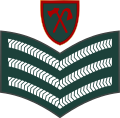 Staff sergeant
Staff sergeant
(Gambian National Army) -
 Staff sergeant
Staff sergeant
(Ghana Army) -
 Staff sergeant
Staff sergeant
(Guyana Army) -
 Staff sergeant
Staff sergeant
(Jamaican Army) -
 Staff sergeant
Staff sergeant
(Kenya Army) -
 Staff sergeant
Staff sergeant
(Lesotho Army) -
 Staff sergeant
Staff sergeant
(Liberian Ground Forces) -
 Staf sarjan
Staf sarjan
(Malaysian Army) -
 ސްޓާފް ސާރޖަންޓް
ސްޓާފް ސާރޖަންޓް
Staaf saarjant
(Maldives National Defence Force) -
 Staff sergeant
Staff sergeant
(Army of Malta) -
 Staff sergeant
Staff sergeant
(Namibian Army) -
 Staff sergeant
Staff sergeant
(New Zealand Army) -
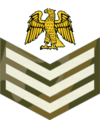 Staff sergeant
Staff sergeant
(Nigerian Army) -
 Stabssersjant
Stabssersjant
(Norwegian Army) -
 Staff sergeant
Staff sergeant
(Rwandan Land Forces) -
 Staff sergeant
Staff sergeant
(Seychelles Infantry Unit) -
 Staff sergeant
Staff sergeant
(Singapore Army) -
 Staff sergeant
Staff sergeant
(South African Army) -
 Staff sergeant
Staff sergeant
(Sri Lanka Army) -
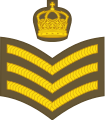 Staff sergeant
Staff sergeant
(Tongan Land Component) -
 Staff sergeant
Staff sergeant
(Ugandan Land Forces) -
 Штаб-сержант
Штаб-сержант
Shtab-serzhant
(Ukrainian Ground Forces) -
 Staff sergeant
Staff sergeant
(British Army) -
 Staff sergeant
Staff sergeant
(United States Army) -
 Staff sergeant
Staff sergeant
(Zambian Army) -
 Staff sergeant
Staff sergeant
(Zimbabwe National Army)
Cadet staff sergeant
The rank of cadet staff sergeant (CSSG or C/SSgt) is used by many cadet organisations around the world, including the Civil Air Patrol in the United States, and the Army Cadet Force and the Army Section of the Combined Cadet Force in the United Kingdom.
Police rank
The rank of staff sergeant is used in some police forces to indicate a senior supervisor. The rank is used, for example, in most Canadian police services. Other national police services (for example, Cyprus) have a corresponding rank of senior sergeant. In the United Kingdom, a few police forces formerly used the rank of station sergeant, with the same rank insignia as an army staff sergeant. The Hong Kong Police Force still uses this rank.
In the Philippines, as of 8 February 2019, the rank of staff sergeant is currently being used by the Philippine National Police as they adopt a new ranking classification, eliminating confusion of old ranks. The rank stands above the Police Corporal and below the Police Master sergeant.
Gallery
-
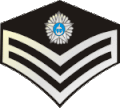 Staff sergeant
Staff sergeant
(Royal Brunei Police Force) -
 Staff sergeant
Staff sergeant
(Royal Canadian Mounted Police) -
 Police staff sergeant
Police staff sergeant
(Maldives Police Service) -
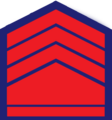 Police staff sergeant
Police staff sergeant
(Philippine National Police) -
 Sierżant sztabowy
Sierżant sztabowy
(Policja) -
 Senior staff sergeant
Senior staff sergeant
(Singapore Police Force) -
 Staff sergeant
Staff sergeant
(Singapore Police Force) -
 Staff sergeant
Staff sergeant
(Vancouver Police Department)
Other uses
A number of other organisations, basing their structure on military ranks, have historically used, or still use, the rank of staff sergeant. The rank of staff sergeant was, for example, phased out of the rank structure of St John Ambulance in the early 1990s.
See also
- Police rank
- Comparative military ranks
- Colour sergeant
- British Army other ranks rank insignia
- Former ranks of the Canadian Armed Forces
- Australian Army enlisted rank insignia
- New Zealand military ranks
- United States Army enlisted rank insignia of World War I
- United States Army enlisted rank insignia of World War II
- U.S. Air Force enlisted rank insignia
- U.S. Army enlisted rank insignia
- U.S. Marine Corps enlisted rank insignia
- U.S. Navy enlisted rate insignia
- United States military pay
References
- "British Army ranks". United Kingdom: National Army Museum. Retrieved 17 April 2018.
- "Staff Sergeant; A history of the rank and some examples of the badge". Digger History. Retrieved 17 April 2018.
- "Other Ranks – Australian Army". Archived from the original on 24 September 2015. Retrieved 7 October 2015.
- "Staff Sergeant". canadiansoldiers.com. Retrieved 2 March 2022.
- "Warrant Officers". canadiansoldiers.com. Retrieved 2 March 2022.
- "About the RCMP". Royal Canadian Mounted Police. Retrieved 27 August 2024.
- "Prop. 111 LS (2014–2015)" (PDF). The Royal Norwegian Ministry of Defence. Retrieved 1 May 2017.
- "Forsvaret innfører ny personellordning". The Norwegian Government. 12 June 2015. Retrieved 2 May 2017.
- "SAF Military Ranks – Specialists". Mindef.gov.sg.
- Singapore Armed Forces ranks
- "Singapore Prison Service / 新加坡监狱部门 – Perkhidmatan Penjara Singapura". uniforminsignia.org. Retrieved 26 November 2018.
- "NCC Ranks and Badges". Anglo Chinese School (Independent). Retrieved 20 November 2018.
- "National Civil Defence Cadet Corps (NCDCC) / National Civil Defence Cadet Corps (NCDCC)". uniforminsignia.org. Retrieved 20 November 2018.
- "National Police Cadet Corps". npcc.org.sg. Archived from the original on 20 November 2018. Retrieved 20 November 2018.
- Pierce, Sammy Anson Black Sheep Ace: Flying Sergeant Sammy Alpheus Pierce Fulton Books, Inc. 6 May 2022
- pp.18-20 Saunders, A. W. (Buck) The Price of Glory: A Military Autobiography 1941-1965 Turner Publishing Company 2001
- "A Short History of the NCO". Archived from the original on 14 April 2008. Retrieved 1 April 2008.
- Perrenot, P. United States Army Grade Insignia Since 1776 (2009).
- "World War II era Marine Corps enlisted ranks". Ww2gyrene.org. Archived from the original on 13 October 2016. Retrieved 1 April 2008.
- Antigua & Barbuda Defence Force. "Paratus" (PDF). Regional Publications Ltd. pp. 12–13. Archived from the original (PDF) on 7 June 2022. Retrieved 2 March 2020.
- "Barbados Defence Force Medal Ceremony". YouTube. Barbados Defence Force. 18 July 2019. Retrieved 29 October 2022.
- "Ranks". Government of Botswana. Archived from the original on 26 August 2016. Retrieved 22 September 2016.
- "Akta angkatan bersenjata diraja Brunei (Penggal 149)" (PDF). agc.gov.bn (in Malay). 16 December 2013. pp. 1999–2000. Retrieved 14 July 2021.
- Merrill, Tim (1993). Guyana and Belize: country studies. Library of Congress. p. 138. LCCN 93010956. Retrieved 3 June 2021.
- "BADGES OF RANK". Official Jamaica Defence Force Website. 2019. Archived from the original on 20 August 2020. Retrieved 16 November 2019.
- "Ranks in the Army". Lesotho Defence Force. Retrieved 5 May 2021.
- "Defense Act of 2008" (PDF). 3 September 2008. p. 8. Retrieved 20 November 2017.
- "Kategori Pangkat". army.mod.gov.my/ (in Malagasy). Malaysian Army. Archived from the original on 28 September 2021. Retrieved 10 July 2021.
- "ރޭންކް ސްޓްރަކްޗަރ". mndf.gov.mv (in Divehi). Maldives National Defence Force. Archived from the original on 29 February 2020. Retrieved 2 June 2021.
- "Rank Insignia". afm.gov.mt. Armed Forces of Malta. Retrieved 26 May 2021.
- "Government Notice" (PDF). Government Gazette of the Republic of Namibia. Vol. 4547. 20 August 2010. pp. 99–102. Retrieved 20 December 2021.
- "Badges of Rank" (PDF). nzdf.mil.nz. New Zealand Defence Force. Retrieved 28 July 2022.
- Smaldone, Joseph P. (1992). "National Security". In Metz, Helen Chapin (ed.). Nigeria: a country study. Area Handbook (5th ed.). Washington, D.C.: Library of Congress. pp. 296–297. LCCN 92009026. Retrieved 21 October 2021.
- "Militære grader". forsvaret.no (in Norwegian). Norwegian Armed Forces. 4 February 2021. Retrieved 26 May 2021.
- "RDF Insignia". mod.gov.rw. Government of the Republic of Rwanda. Retrieved 12 June 2021.
- "Rank structure". spdf.sc. Seychelles People's Defence Forces. Retrieved 4 June 2021.
- "SAF Rank Insignias". mindef.gov.sg. Ministry of Defence (Singapore). Retrieved 7 June 2021.
- "Uniform: Rank insignia". army.mil.za. Department of Defence (South Africa). Archived from the original on 20 October 2020. Retrieved 29 May 2021.
- "Dress Regulation PDF - Part I" (PDF). army.lk. Sri Lanka Army. January 2019. pp. 10-4 – 10-11. Retrieved 20 May 2021.
- "Other Ranks". army.lk. Sri Lanka Army. Retrieved 24 September 2021.
- "Tonga Defence Services (Amendment) Regulations 2009" (PDF). Tonga Government Gazette Supplement Extraordinary. 5: 151–153. 10 May 2010. Retrieved 26 September 2021.
- "Uganda Peoples' Defence Forces Act" (PDF). The Uganda Gazette. CXII (46). Uganda Printing and Publishing Corporation: 1851–1854. 18 September 2019. Archived from the original (PDF) on 14 August 2021. Retrieved 29 May 2021.
- "НАКАЗ 20.11.2017 № 606". zakon.rada.gov.ua (in Ukrainian). Ministry of Justice of Ukraine. 13 December 2017. Retrieved 2 June 2021.
- "Rank structure". army.mod.uk. British Army. Retrieved 27 May 2021.
- "U.S. Army Ranks". army.mil. United States Army. Retrieved 27 May 2021.
- "Royal Brunei Police Force". International Encyclopedia of Uniform Insignia. Archived from the original on 20 March 2020. Retrieved 20 March 2020.
- "Ranks of the Force". rcmp-grc.gc.ca. Royal Canadian Mounted Police. 21 May 2015. Retrieved 25 January 2021.
- "Rank Insignias". Maldives Police Official Website. Retrieved 15 February 2021.
- Sadongdong, Martin (26 March 2019). "Modified PNP rank classification takes effect". Manila Bulletin. Archived from the original on 28 March 2019. Retrieved 28 March 2019.
- "Rozporządzenie Rady Ministrów z dnia 21 czerwca 2019 r. w sprawie stopni policyjnych, Agencji Bezpieczeństwa Wewnętrznego, Agencji Wywiadu, Biura Ochrony Rządu, Służby Ochrony Państwa, Państwowej Straży Pożarnej, Służby Kontrwywiadu Wojskowego, Służby Wywiadu Wojskowego, Służby Więziennej lub Straży Granicznej odpowiadających poszczególnym stopniom wojskowym" [Regulation of the Council of Ministers of 21 June 2019 on the ranks of the Police, Internal Security Agency, Foreign Intelligence Agency, Government Protection Bureau, State Protection Service, State Fire Service, Military Counterintelligence Service, Military Intelligence Service, Prison Service or Border Guard corresponding to individual ranks military.] (PDF). Internetowy System Aktów Prawnych (in Polish). Retrieved 23 April 2020.
- ^ "Ranks and drill commands". cmpb.gov.sg. Ministry of Defence. Retrieved 4 February 2021.
- "The Job | Vancouver Police Department". Vancouver.ca. Retrieved 3 May 2017.
External links
- United States Army Staff Sergeant duties
- U.S. Army Enlisted Rank Insignia – Criteria, Background, and Images
- http://www.Army.mil
- Military ranks of the Commonwealth
- Military ranks of Australia
- Military ranks of Canada
- Military ranks of Singapore
- Military ranks of the British Army
- Military ranks of the United States Army
- Enlisted ranks of the United States Air Force
- Police ranks
- United States military enlisted ranks
- Staff (military)
- Military ranks of the United States Marine Corps
- Former military ranks of Canada